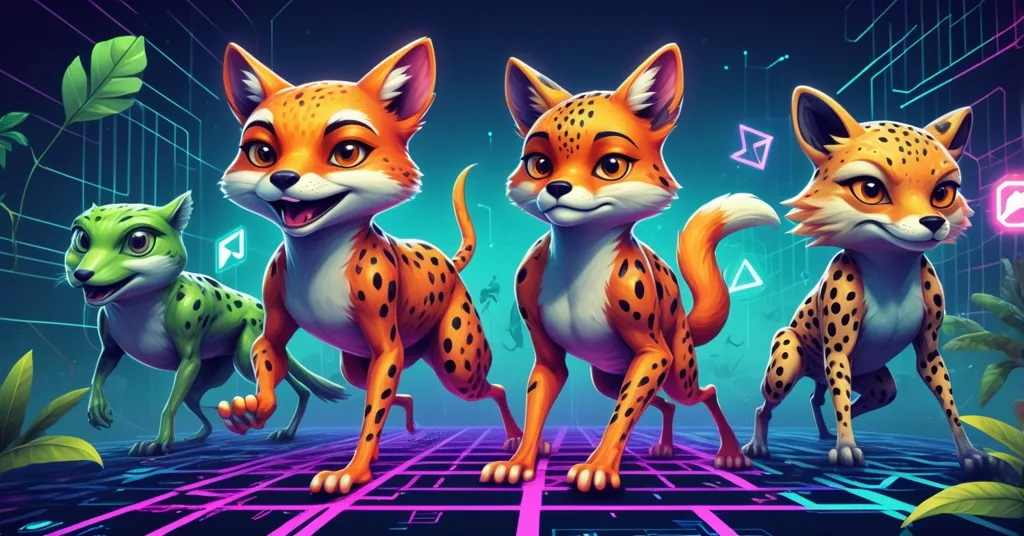3 Ethereum Meme Coins Beating Pepe Coin in 2025: LILPEPE, TURBO, FLOKI

3 Ethereum-Based Meme Coins Outshining Pepe Coin (PEPE) in 2025
Pepe Coin (PEPE), the frog-faced darling of the 2023 meme coin frenzy, seems to be croaking under the weight of its own nostalgia in 2025. While it once captured the internet’s chaotic energy, a new wave of Ethereum-based meme coins is hopping ahead with tech, community grit, and even some real-world utility. Let’s dissect three contenders—Little Pepe (LILPEPE), Turbo (TURBO), and Floki Inu (FLOKI)—that are challenging PEPE’s faded crown and ask if they’re truly the future or just another speculative fever dream.
- PEPE’s Decline: Once a viral sensation, PEPE lacks utility and ecosystem growth to keep up with 2025’s innovative meme coin standards.
- Rising Contenders: LILPEPE, TURBO, and FLOKI bring fresh tech, organic support, and diverse value to Ethereum’s meme coin arena.
- Big Question: Are these tokens redefining the meme coin game, or are they just the latest hype bubble waiting to burst?
Why Meme Coins Matter (and Why They Don’t) on Ethereum
Meme coins started as the crypto world’s punchline—tokens like Dogecoin (DOGE) born from internet jokes that somehow turned into speculative goldmines by 2021. They’ve since become a gateway for new users, drawing millions into blockchain with their absurd charm and promise of quick riches. On Ethereum, the hub of decentralized apps and smart contracts, meme coins thrive thanks to a massive developer community and infrastructure that lets anyone spin up a token in minutes. They’re a double-edged sword: a fun on-ramp to crypto adoption, but often a cesspool of scams and pump-and-dumps that tarnish the industry’s rep. As Bitcoin maximalists, we can’t help but grimace—meme coins distract from the sound money revolution BTC champions. Yet, Ethereum fills niches Bitcoin doesn’t touch, like smart contract ecosystems fueling these viral experiments, as explored in this guide to 2025 meme coin trends and risks. So, while we root for decentralization, let’s not pretend meme coins are anything but a wild west casino—entertaining, risky, and occasionally innovative.
Pepe Coin’s Fall: A Brief History of Hype and Stagnation
Back in 2023, Pepe Coin exploded onto the scene, riding the wave of internet meme culture with its iconic frog imagery. It wasn’t about utility; it was pure, unadulterated hype—a community-driven rocket that soared on viral tweets and Reddit threads. At its peak, PEPE’s market cap hit billions, proving that sentiment could trump substance in crypto. Fast forward to 2025, and the story’s different. Without a robust ecosystem, scalability solutions, or tangible use cases, PEPE’s stuck in the past. Its ERC-20 token structure on Ethereum offers nothing beyond basic trading, while newer projects build platforms, games, and financial tools. For a deeper dive into the roots of such meme cryptocurrencies like PEPE, the history speaks volumes. PEPE’s fall isn’t just a cautionary tale; it’s a reminder that hype alone can’t sustain a token when the market starts craving something real—or at least the illusion of it.
Little Pepe (LILPEPE): A Tech-Driven Spiritual Successor
What if meme coins weren’t just digital gags, but had their own high-speed blockchain to play on? Enter Little Pepe, or LILPEPE, which isn’t content to merely mimic PEPE but aims to rewrite the meme coin rulebook. Billed as the first Ethereum-compatible Layer-2 blockchain tailored specifically for meme coins, LILPEPE tackles the bane of Ethereum users: sky-high gas fees and sluggish transactions. For the unversed, a Layer-2 solution is like an express lane on a clogged highway—it processes transactions faster and cheaper while still tapping into Ethereum’s base security. This setup could be a game-changer for meme coin launches plagued by cost and speed issues.
LILPEPE’s toolkit is packed with goodies: sniper-bot protection (safeguards against automated bots that snatch tokens at launch to jack up prices), zero trading taxes to keep costs minimal, and liquidity locks via its launchpad, Pepe’s Pump Pad, to ensure fair launches for new meme projects. It’s not just a token; it’s a breeding ground for the next meme coin wave, prioritizing security and scalability. Sitting at Stage 5 of its presale with a token price of $0.0014, LILPEPE has raised nearly $5 million, with earlier stages selling out fast. Two top-tier exchange listings are confirmed, and a $777,000 giveaway is stirring loud chatter—though noise doesn’t always equal substance. Check out the buzz around LILPEPE’s presale and upcoming exchange listings for more on its trajectory. Some analysts even suggest LILPEPE could rival Dogecoin in the next market cycle, a bold claim for a project still in its infancy.
Yet, here’s the rub: the team behind LILPEPE remains anonymous, a glaring red flag in a space littered with rug pulls—scams where developers vanish with investor funds. And how does its Layer-2 tech stack up against proven solutions like Arbitrum or Optimism? A meme-focused blockchain sounds niche, but scalability and security trade-offs could bite if not battle-tested. For community insights, some discussions on LILPEPE’s Layer-2 potential highlight both hype and hesitation. While the presale hype is real, meme coins live and die by community fervor. If the buzz fades post-launch, LILPEPE could be another forgotten frog. For now, it’s a frontrunner with serious tech muscle, but skepticism is your best wallet protector.
Turbo (TURBO): An AI Prank Turned Community Juggernaut
Born from a $69 AI experiment, Turbo, known as TURBO, proves meme coins can roar without millionaire shills. Created using GPT-4 as a quirky test of AI-driven token design, this Ethereum-based project started as a gimmick and ballooned into a community powerhouse. By July 2025, TURBO reportedly pulls daily trading volumes over $15 million on decentralized exchanges (DEXs)—platforms like Uniswap where tokens swap peer-to-peer without middlemen. That’s impressive for a token without flashy influencer backing, relying instead on raw grassroots momentum across X and Telegram. For a closer look at TURBO’s community-driven growth, the numbers tell an intriguing story.
Whale accumulation, where big-pocket investors scoop up massive token chunks, was spotted in June and July 2025, often a sign of confidence—or manipulation, let’s not be naive. Some enthusiasts on X speculate wild gains of 10x to 50x during the next “meme season,” those frenzied periods when speculative fever grips crypto markets. Spare us the fairy tales, though; meme coins aren’t lottery tickets. Get more on TURBO’s trading volume and whale activity data for July 2025 to see the hard stats. TURBO’s charm lies in its organic growth, a middle finger to over-hyped, cash-fueled launches. But with no utility beyond good vibes, its grassroots appeal could wither if sentiment sours. Community is king until the next shiny toy steals the crowd. TURBO’s a dark horse on Ethereum’s meme track, but it’s running on fumes of faith for now.
Floki Inu (FLOKI): A Meme Coin with Real-World Ambition
Gaming with Valhalla
Floki Inu, or FLOKI, refuses to be just another Dogecoin wannabe. Priced around $0.000074 in 2025, with a $50 million ecosystem treasury, FLOKI is gunning for legitimacy through utility. Its flagship project, Valhalla MMORPG, launched its mainnet on June 30, 2025, on opBNB, a Layer-2 network by BNB Chain designed for low-cost transactions. Valhalla is a play-to-earn game integrating non-fungible tokens (NFTs)—unique digital assets you can own, trade, or flex in-game. It’s a bid to merge crypto with gaming culture, targeting a dual audience of blockchain nerds and traditional gamers. Learn more about FLOKI’s Valhalla mainnet launch and ecosystem updates for the latest developments. Compared to heavyweights like Axie Infinity, Valhalla’s success hinges on user adoption, an area where details are still speculative.
DeFi and Education Push
FLOKI isn’t stopping at gaming. It’s got FLOKI University for blockchain education, teaching the masses about crypto, and FlokiFi, a decentralized finance (DeFi) protocol for staking and yield farming—locking up tokens to earn rewards. Compared to established DeFi players like Aave or Compound, FlokiFi’s scale is unclear, but the ambition is there. For a broader perspective on FLOKI’s utility in gaming and DeFi, community insights shed some light. With over 500,000 holders and partnerships spanning esports teams like Method, NGOs, and educational platforms, FLOKI’s ecosystem is sprawling. Marketing is its secret sauce: Times Square billboards, ads on Bloomberg and Fox Business, and a five-week in-game ad campaign aiming for 2.25 million impressions in India, Nigeria, and Indonesia. It’s got more projects than a tech startup pitch deck—let’s hope it’s not spreading itself thinner than a cheap NFT knockoff.
Still, at such a dirt-cheap price point, volatility rules. Small pumps can spiral into brutal dumps overnight. Is FLOKI overreaching with too many irons in the fire, or is this the blueprint for meme coins to grow up? It’s carving a path beyond PEPE’s one-note hype, but juggling gaming, DeFi, and education risks losing focus. Sustainability sounds nice, but in meme coin land, chaos often wins.
The Dark Side: Meme Coins as Decentralized Casinos
Let’s not drink the Kool-Aid just yet. Meme coins, even with shiny tech or utility, are speculative minefields. Hype builds empires overnight—until the crown slips and bagholders are left burned. LILPEPE’s anonymous team could pull a disappearing act, a la the infamous SQUID Game token scam of 2021 that fleeced investors for millions. TURBO’s feel-good community story might mask coordinated whale dumps. FLOKI’s utility push could be marketing spin for the same old speculation. Regulatory shadows loom larger in 2025—look at the SEC’s ongoing war on unregistered securities like Ripple’s XRP. Meme coins could be next on the chopping block. And let’s ask the hard question: do these Ethereum experiments help or hurt blockchain’s core promise of decentralization? Are they drawing new users or just repackaging casinos with a decentralized label? Bitcoin’s mission of sound money feels miles away when frogs and dogs dominate the headlines.
Comparing the Contenders: Strengths and Pitfalls
- Little Pepe (LILPEPE): Strength – Layer-2 tech for meme coins with scalability and security features; Risk – Anonymous team and untested infrastructure.
- Turbo (TURBO): Strength – Organic community growth with high DEX volumes; Risk – No utility beyond sentiment, prone to hype fatigue.
- Floki Inu (FLOKI): Strength – Diverse utility in gaming, DeFi, and education with aggressive marketing; Risk – Overextension across projects and inherent volatility.
Key Takeaways and Questions for Reflection
- Why is Pepe Coin (PEPE) fading in 2025?
PEPE’s stuck in a 2023 time warp, banking on nostalgia without utility or ecosystem growth, outpaced by Ethereum meme coins with real innovation. - What makes Little Pepe (LILPEPE) a potential disruptor?
Its Layer-2 blockchain, built for meme coins with speed and security perks, plus a hot presale, sets it apart—though anonymity sparks trust concerns. - How does Turbo (TURBO) punch above its weight?
Starting as a $69 AI experiment, TURBO’s grassroots community and high trading volumes on Ethereum DEXs show raw power, but lack of purpose looms as a flaw. - Can Floki Inu (FLOKI) redefine meme coins with utility?
FLOKI’s push into gaming, DeFi, and education on Ethereum aims for longevity, backed by bold marketing, though juggling too much risks collapse—and volatility reigns. - Do Ethereum meme coins drive blockchain adoption?
They lure new users with viral appeal, boosting Ethereum’s ecosystem, but their speculative chaos often fuels scams, denting decentralized tech’s credibility. - What are the real dangers with these 2025 meme coins?
Volatility, regulatory heat, and shady practices like rug pulls are constant threats—investors must navigate this Ethereum wild west with eyes wide open.
Navigating Ethereum’s meme coin jungle demands a sharp mind and thicker skin. LILPEPE, TURBO, and FLOKI each offer something fresh—cutting-edge tech, community spirit, or diversified utility—while PEPE’s fall reminds us that today’s meme king can be tomorrow’s forgotten joke. The crypto market bows to value, innovation, and survival, not viral frogs. As we champion decentralization and effective accelerationism, we see Ethereum’s role in pushing boundaries Bitcoin doesn’t reach. But let’s cut the fluff: meme coins are a gamble, often a distraction from blockchain’s deeper mission. So, are these tokens the future of Ethereum’s wild side, or just another circus act? Your skepticism might be the best shield for your wallet.



